European practice, with special reference to the electric locomotive development of Switzerland and Italy
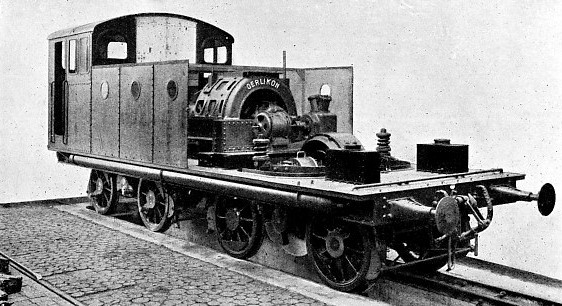
THE FIRST ELECTRIC LOCOMOTIVE ON THE SEEBACH-WETTINGEN RAILWAY, 1904. It is of the B-B type (0-4-4-0) with driving wheels of 39⅜ inches in diameter. The single cab set
at the rear recalls familiar steam locomotive practice.
WHILE electric locomotive design has seemingly settled into well-defined channels in the United States, it is still being pursued experimentally in Europe. This is due to the engineers realizing that we are still far from having attained the stage when any attempt at standardization care be made. Also, it must be remembered, railway electrification is being carried out upon ambitious scales, because it is the objective of certain nations, especially those which have to import all mineral fuel, to abandon steam-working in its entirety.
This sustained stimulation of investigation and research has attained its highest level in Switzerland. The locomotives have not been carried to the limits of weight, dimensions and power recorded in the United States of America, but in many respects are more interesting, inasmuch as they represent more determined effort to solve the many peculiar and abstruse technical problems incidental to this form of traction. Hence the diversity of types.
One of the first Swiss trunk railways to be converted to electricity was that from Seebach to Wettingen. This was carried out in 1904, when electric traction, so far as railways are concerned, was in its infancy. Consequently the line was more or less an experiment. The pioneer electric built by the Swiss manufacturers, Ateliers de Construction Oerlikon, with two groups of two coupled axles, was of the B-B type, with driving wheels 39⅜ inches in diameter. It recalled the steam locomotive in its tout ensemble, because the familiar cab was set at the rear. Single-phase current, supplied through overhead conductors at 15,000 volts, 50 cycles, was used, and stepped down on the locomotive through an air-cooled transformer to 700 volts. It was then passed through a rotary converter group comprising a 650-horse-power motor coupled direct to a 400-watt, 600-volt dynamo for conversion into direct current, with which the 200-horse-power motors, one to each pair of driving axles, was driven.
This was followed by an Oerlikon locomotive, which in body conforms to general electrical practice, with foot-plate at each end. It is also of the B-B type, collecting current from the overhead conductor at 15,000 volts, stepped down by air-cooled transformer to 700 volts for the variable voltage motors; one of these is mounted on each pair of axles and the drive transmitted through gearing and side rods. The motors develop 250 horse-power each when running at the normal speed of 650 revolutions per minute, but it is possible to accelerate to a maximum of 1,000 revolutions a minute, giving the locomotive a speed of 37½ miles an hour.
When the charter was granted for the driving of the Lotschberg Railway, with its tunnel through the Bernese Alps, thus continuing the Simplon Railway from Brigue, it was stipulated that it should be electrically operated. The road, as may be expected from traversing mountainous country, is arduous. At Brigue the rails are 2,234.5 feet above sea-level, rising to the summit-level of 4,077.4 feet in the great tunnel, over nine miles in length, and then falling to 2,070.16 feet at Spiez. The gradients are heavy; the maximum rise reaches 1 in 37.03, while the sharpest curves are of 984-4 feet radius. Another adverse feature are the two spiral tunnels introduced near Blausee-Mittholz to maintain the working grade.
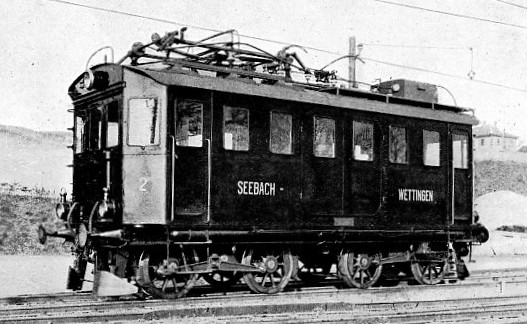
PRESENT TYPE OF ELECTRIC LOCOMOTIVE IN SERVICE UPON THE SEEBACH-WETTINGEN RAILWAY. Built by the Ateliers de Construction Oerlikon, it is of the B—B type
(0-4-4-0) and has a footplate at each end. This electric has a maximum speed of 37½ miles per hour.
In 1910 two experimental locomotives were acquired, the one from a German firm and the other from the Ateliers de Construction Oerlikon. Both developed 2,000 horse-power, but were of different design. As the result of the exacting competitive trials only the Swiss locomotive was kept in service. This has twelve driving wheels, divided into two groups with external coupling rods, and mounted in articulated trucks, giving the classification C+C. There are no guiding trucks, while each group of wheels receives its power from the 1,000-horse-power motor mounted thereon through a rod connected to a jack-shaft, thence to the third axle of each group.
As the result of the experience gained with this locomotive, the Swiss Federal Railways ordered thirteen electrics, each developing 2,500 horse-power, from the Ateliers de Construction Oerlikon and Messrs. Brown, Boveri, and with these the line was opened for international traffic on September 18, 1913. Each locomotive measures 52½ feet in length; the driving wheels, 63.14 inches in diameter, are ten in number, and coupled, with a guiding truck at each end. As the electric can be driven from either end, this really represents the electrical counterpart of the steam “Decapod”; and from the fact that the five coupled driving axles are carried in the one frame the Continental electrical classification reads 1-E-1.
The drive from the two 1,250-horse-power motors is through gearing to intermediate, or jack-shafts, and then through a set of triangular rods and ordinary side coupling rods to the driving wheels. The total weight of the locomotive is 239,680 lb.; of this amount 175,168 lb. are available for adhesion. In starting a tractive effort of 39,600 is developed. This electric will haul a train weighing 310 tons over the maximum banks of 1 in 37.03. On heavy grades it can attain a speed of 25 miles an hour for an hour and a half, while its maximum speed, the highest permitted by the authorities, is 45.62 miles an hour.
Towards the end of the 1880s private enterprise embarked upon the weaving of a network of secondary railways through the mountainous Engadine country. This system, known as the Rhaetian Railways, in point of engineering achievement is one of the most remarkable in Switzerland, for the country threaded is of a rugged character. Nevertheless, through touching many of the important centres away from the main lines, and thus serving as an interconnecting link, these roads, aggregating more than 150 miles, have become of primary importance, handling an enormous volume of traffic, both through and local.
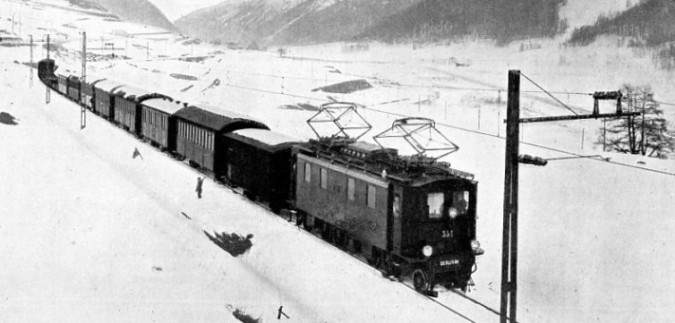
MIXED TRAFFIC ON THE ELECTRIFIED SECTION OF THE RHAETIAN RAILWAYS. The Oelikeon electric locomotives (1-D-1) in use have an overall length of 35 feet 4 inches; driving and carrying wheels of 42 and 27.9 inches diameter respectively; a total weight of 110,969.6 lb., with 88,818.4 lb. available for adhesion.
In 1913 it was decided to convert this network from steam to electricity. The first section to be taken in hand was that between Schuls, Bevers, Davos and Pontresina, a distance of about 30 miles, but electrification is to be continued, stage by stage, until the complete system has been released from its servitude to steam. The sectional character of this gridiron facilitates such a change-over with the minimum of inconvenience or interruption to traffic.
For the operation of the first division several designs of electric locomotives have been acquired. One of the 1-D-1 class, developing 600 horse-power, was ordered from a German company; a similar unit and one of the 1-B-1 class of 300-horse-power from Messrs. Brown, Boveri and Company; two locomotives of the 1-D-1 type, of 600 horse-power, and three others of 800 horse-power from the Ateliers de Construction Oerlikon. The conditions to be satisfied were somewhat exacting. The Rhaetian Railways are narrow gauge — metre or 3 feet 3⅜ inches — with minimum curves of 262½ feet radius and a ruling grade of 1 in 40. The load per axle was limited to 24,640 lb., and the maximum speed to 31¼ miles per hour. The locomotives developing 600 horse-power were to be able to haul a train of 180 tons at 17½ miles per hour over the 1 in 40 banks. These requirements demanded a tractive effort of 12,672 lb. at the tread of the wheel.
The Oerlikon electrics have an overall length of 35 feet 4 inches. The driving wheels are 42 inches and the carrying wheels 27.9 inches in diameter respectively. The total weight of the locomotive is 110,969.6 lb.; of this 88,818.4 lb. are available for adhesion. The weight imposed upon each of the driving axles is 22,204.6 lb., with 11,075.6 lb. upon each guiding truck axle; the axle-load requirement is thus easily met. There are two motors, of 300-horse-power each, mounted end to end in the centre, and upon the floor of the chassis, transmitting their power through a single gear-wheel mounted between the two motor armatures, and engaging with pinions on the latter and intermediate shafts to the four coupled axles. The success of these units induced the Rhaetian Railways to acquire three additional Oerlikon locomotives of the 1-D-1 class. They are identical in every respect, except that they develop 800 horse-power.
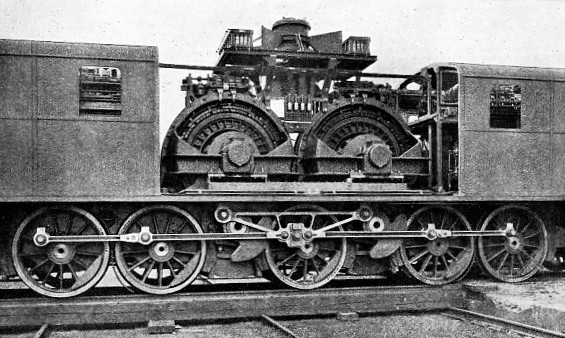
AN OERLIKON ELECTRIC “DECAPOD” (1-E-1) ON THE LOTSCHBERG RAILWAY. It has five coupled axles with a pony truck at each end. The ten driving wheels are each of 63.14 inches in diameter; the overall length of the locomotive is 52½ feet, and the total weight 239,680 lb.
The seven 300-horse-power Brown-Boveri locomotives of the 1-B-1 class for the Lower Engadine section of the Rhaetian Railways have driving and carrying wheels of the same diameter as those just mentioned. They measure 28 feet 6 inches in length and weigh 82,880 lb. They are equipped with a single 300-horse-power single-phase motor, and by vertical rods and jack-shafts deliver the power to the four coupled wheels. They are designed to haul a passenger train weighing 53 tons, exclusive of the locomotive, at an average speed of 22½ miles an hour on the level, and af 17½ miles an hour over the steepest grade, while their maximum speed is 28.25 miles an hour. The Brown-Boveri 600-horse-power locomotive built for the same system is of the 1-D-1 class, but the transmission from the motors follows distinctive lines; there is an intermediate shaft extending from the cranks mounted on each motor to central cranks on the side-coupling rods, and the disposition of the motor shafts is such that it resembles a widely opened “V”.
The conversion of the great trunk road of Switzerland, the St. Gothard Railway, from steam to electricity has provided the domestic manufacturers with every scope for the manifestation of their ingenuity to meet official requirements, both for passenger and freight traffic, and for this two different types of locomotives are required; haulage effort rather than speed is demanded for the latter service. The Oerlikon locomotives may be said to represent a Swiss endeavour to emulate American practice in point of dimensions. They have twelve driving wheels divided into two groups, with a guiding truck at each end, giving the Continental classification 1-C-C-1 or 2-6-6-2. The driving wheel bogies are so made that they are interchangeable.
The Brown-Boveri passenger locomotive has eight driving wheels disposed in two groups, and with end guiding trucks, giving the arrangement 1-B+B-1. The passenger locomotives weigh 241,024 lb., and those designed for freight service 271,040 lb. The locomotive is driven by four motors, each developing 430 horsepower, and at the speed of 37½ miles per hour develops a tractive effort of 15,620 lb.
Electric Development in Italy
In Italy the electrification of the main line railways is proceeding apace, and for the same economic reason as that guiding the movement in Switzerland — emancipation from imported coal. Among the many and varied locomotives which have been delivered to the state is an Oerlikon 2-C-2 built conjointly by the Swiss engineers and the Construzioni Meccaniche di Saronno of Milan. As the classification implies, this comprises six coupled wheels with a four-wheeled bogie guiding truck at either end for operation with a line voltage of 3,300 at 16 2/3 cycles. The locomotive is 43 feet 10 inches in length, and has a fixed wheel-base of 11 feet 9¾ inches. The driving wheels are 64.17 inches in diameter and carry 120,960 lb. of the 206,080 lb. constituting the total weight of the engine — 40,320 lb. per driving axle.
The locomotive has four defined speeds — 23.43, 31.25, 46.8 and 62.5 miles an hour respectively; at these 1,250, 1,870, 2,640 and 2,220 horse-power are delivered to the tread of the wheel, while the tractive effort at the four speeds with the mentioned outputs are 19,800, 19,800, 20,900 and 13,200 lb. for one hour, with a maximum starting draw-bar-pull of 26,400 1b. There are two motors, one driving each group of coupled wheels, rated at 1,450 horse-power at 250 revolutions per minute, corresponding to a speed of 46.8 miles an hour, and they weigh 98,560 lb. complete. The power is transmitted from the crank-pin of the stator armature to the slide-bearing on the crankshaft, whence it is transmitted to the ordinary side-coupling rods. Speed variations are forthcoming from the coupling of the motors in cascade or in parallel, the
former giving the two lower, and the latter the two higher speeds.
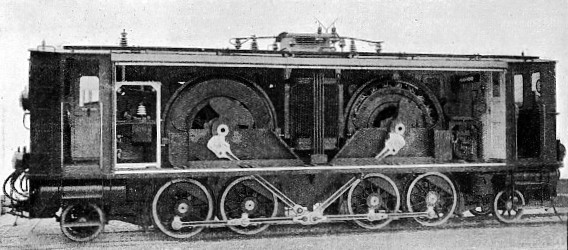
BROWN-BOVERI ELECTRIC 600-HORSE-POWER LOCOMOTIVE (1-D-1) ON THE RHAETIAN RAILWAYS. An interior view of the distinctive methods of mounting the motors and the transmission of the power to the eight driving wheels; the disposition of the motor shafts resembles a widely opened “V”.
Upon delivery the Italian State Railway subjected the locomotive to a series of interesting tests upon the electrified sections of the national system — Genoa-Savona, Genoa-Ronco and Lecco-Monza — in Upper Italy. The first trials, to determine the power of the motors, involved starting upon a bank rising 1 in 62-5 with an attached load of 270 tons, and accelerating to the speed of 46-8 miles per hour, which was accomplished in 500 seconds. The guaranteed tractive efforts were forthcoming at all four definite speeds, and the maximum was obtained between 31.25 and 46-8 miles per hour.
Twenty-two successive starts with a train load of 350 tons and acceleration up to 31.25 miles an hour were made upon a grade of 1 in 33.3, at intervals of three minutes, to test the efficiency of the resistances and their temperature fluctuations. Road trials were also conducted to ascertain the power and speed performances of the locomotive, as well as temperature rises in the electrical equipment. One of these trials comprised six round trips between Genoa and Savona, a total distance of 312½ miles, completed in 22 hours, with an attached train load of 407 tons, and at speeds of 23.43, 31.25 and 46.8 miles per hour, with stops at the numerous stations en route.
Another series of trials to the same end were made on the Lecco-Monza line; six round trips were completed in the course of 20 hours with a train load of 180 tons, exclusive of the locomotive. The aggregate distance covered was 332½ miles. On this occasion higher speeds were made up to the maximum of 62½ miles an hour. These searching trials were found to have exercised no ill-effects upon the locomotive; accordingly it was passed into the regular train service the following day.
Three interesting trials were carried out with abnormal train weights and lengths under conditions of double locomotive operation. The one locomotive was coupled to the head of the train, while the second electric was placed at the rear for pusher service. The purpose was to attain speeds of 31.25, 47.8 and 62.5 miles an hour respectively, with the loads hauled, and over grades ranging from 1 in 83 to 1 in 143. In the first trial, when the speed of 31.25 miles an hour was recorded on the grade of 1 in 83, the train load, exclusive of the engine, was 690 tons distributed over 70 axles. In the second instance the speed of 31.25 miles an hour was reached on the same grade with an attached load of 668 tons borne on 90 axles. In the third run, when the maximum speed of 62½ miles an hour was attained, the train load was reduced to 367 tons on 50 axles, and the incline to 1 in 143.
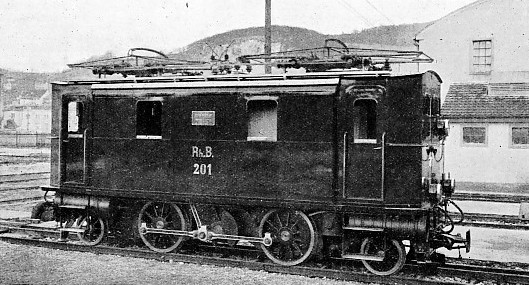
BROWN-BOVERI ELECTRIC 300 HORSE-POWER LOCOMOTIVE
(1-B-1) ON THE RHAETIAN RAILWAYS. The overall length is 28 feet 6 inches, and the total weight scales 82,880 lb. A maximum speed of 28.25 miles per hour is attained.
So far as Great Britain is concerned, the electric locomotive has not undergone any decided development for working the trunk roads. Several factors have contributed to this seeming lack of enterprise, notably doubt as to whether any financial advantage would accrue from such a conversion under the peculiar domestic conditions-prevailing in regard to the cost of the respective forms of energy — steam and electricity. So far as the issue has been examined, electricity can offer no advantage over its steam rival in the cost of power sense, because the country possesses no sources of cheap hydro-electric supply. Economies can only result from the increased gross earnings incidental to electrical operation, combined with decreased operating and maintenance charges.
Moreover, the development has not yet emerged from the experimental epoch, as it is evidenced by consideration of American and European practice, the former striving to uphold the principle of mounting the motors on the axles for either direct drive or through reduction gearing, while the latter prefers the side-coupling-rod method
of transmission. There has also been considerable conflict of opinion in regard to current supply, which is probably a more contentious problem than any other. The British railways did not desire to witness another “Battle of the Gauges” in regard to this factor, but the air has been cleared by the Advisory Committee of the Ministry of Transport definitely recommending the adoption of direct current at 1,500 volts as the standard for the country.
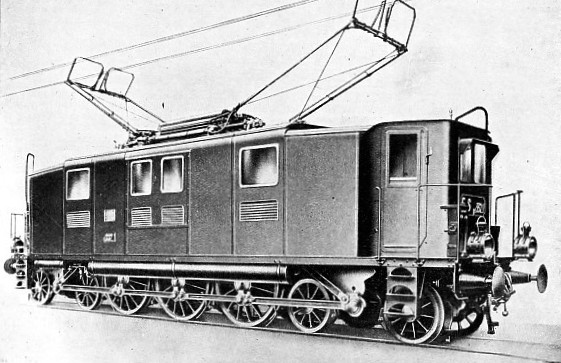
ELECTRIC LOCOMOTIVE
(2-C-2) OF THE ITALIAN STATE RAILWAYS. It has six-coupled-wheels with a four-wheeled bogie guiding-truck at each end. The driving wheels are 64.17 inches in diameter, and the overall length is 43 feet 10 inches.
The new movement was initiated in Britain by the North Eastern division of the London and North Eastern Railway with electrics built at the Darlington locomotive shops for the haulage of mineral traffic over the electrified Shildon-Newport line. These locomotives, of the 0-4-4-0 type —Continental classification B+B — have two articulated trucks with a wheelbase of 8 feet 9 inches carrying driving wheels 48 inches in diameter, and weighing 168,000 lb. complete; the whole of this amount is available for adhesion. There are four motors, two mounted in each bogie truck, permanently connected in series, each driving an axle through gearing, capable of developing 275 horse-power at a speed of 20 miles an hour for one hour. In starting the locomotive develops a tractive effort of 28,000 lb., and will haul a train of 1,400 tons at 25 miles an hour on the level. The body is of the modified steeple type, with the driving cab in the centre, but as easily capable of driving in either direction as those with the motor compartments at the extreme ends of the more generally favoured box type of body.
To determine the comparative operating results of steam and electricity some interesting trials were carried out on the Shildon-Newport line, a distance of 17½ miles, with a maximum grade of 1 in 103. A steam locomotive, designed for freight haulage, and of approximately equal adhesive force, was pitted against the electric in the movement of a train weighing 1,003 tons. These tests comprised respectively a through non-stop run, a trip with three intermediate stops at the foot of the heaviest banks, and the third journey with stopping and re-starting on the maximum grades. The electric proved the victor; it completed the three trips in 173 minutes, whereas the steam locomotive occupied 321 minutes. The difference in favour of the electric, however, was due primarily to the delay of the steam locomotive after the second journey for the purpose of cleaning fires.
The latest development of the London and North Eastern Railway in the electric traction field is a high speed passenger locomotive of the 4-6-4 (2-C-2) class, with driving wheels 80 inches in diameter. It measures 53 feet 6 inches overall, with a rigid wheel-base of 16 feet, by 8 feet 10 inches overall width, and a total weight of 228,480 lb., with 124,320 lb. on the drivers. The Metropolitan-Vickers motors have a collective capacity of 1,260 horsepower under continuous rating, and are able to develop 1,800 horse-power for one hour. This electric has a safe maximum speed of 90 miles an hour, and hauls a 450-ton train at an average speed of 65 miles an hour.
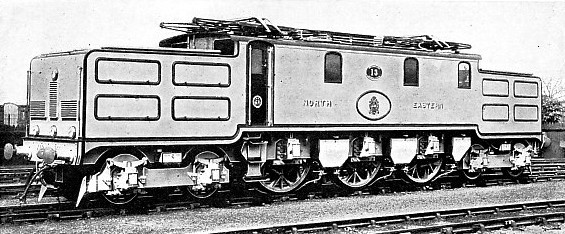
LONDON AND NORTH EASTERN LATEST TYPE OF ELECTRIC LOCOMOTIVE (4-6-4). It has driving wheels of 80 inches in diameter, and an overall length of 53 feet 6 inches.
You can read more on “Electric Locomotive Classification 1”, “Electric Traction” and “Electrification in Europe” on this website.










